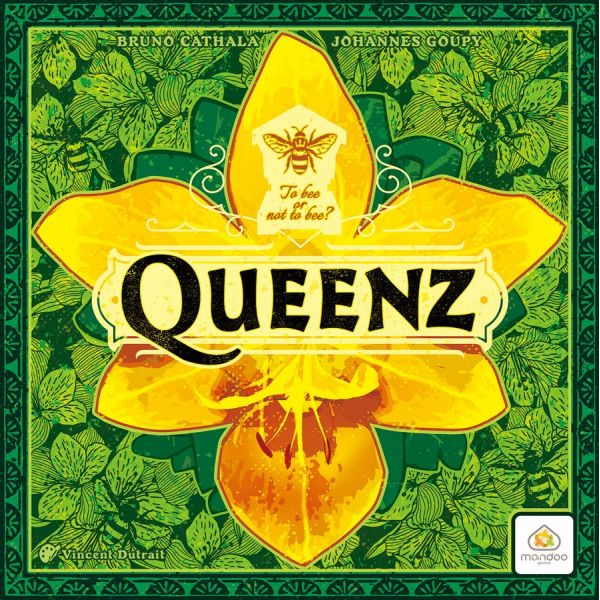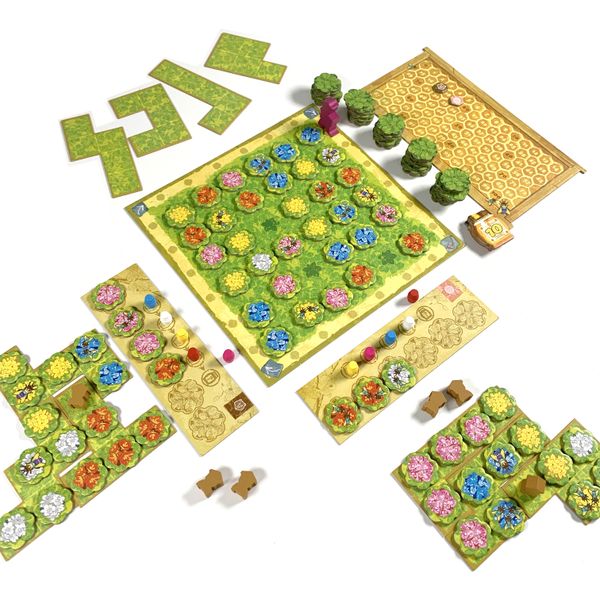To Bee or Not to Bee? Attract Bees to Your Flower Garden in Queenz

Carefully create fields of colorful flora to attract busy bees in the latest from Bruno Cathala and Johannes Goupy.
Gameplay
Queenz: To Bee or Not to Bee is a 2-4 player game mixing set collection and polyomino puzzling in a quick and light game. Players begin with their own player boards where they will collect and house flowers from a shared central board of flowers. A beekeeper meeple will alert players to which row or column they can choose with each turn.
Players will begin by choosing from one of three actions carried out on the main board: selecting three differently colored flowers, two flowers of any color (so two of the same color are allowed), or one flower of any color or a flower with bees. They can carry these out based on where the beekeeper is positioned. Once a player carries out their chosen action, they will add the flower(s) to their own board and move the beekeeper that many spaces along the board. The next player will choose from the new row and column what flower(s) they wish to collect and move the beekeeper accordingly.
Players may only hold up to six flowers on their individual boards. Once a player has collected five or six flowers, they must spend their turn choosing one of the five polyominoes from the general pool. The polyominoes are different shapes, each with five spaces. When a player takes a polyomino, they must fill each space. The goal is to group flowers by color, with any grouping scoring as many points as flowers within it. For example, if a player plays three white and two pink flowers, they will gain three points for the white flowers plus two points for the pink flowers for a total of five points. As players accumulate more flowers of the same color and grab additional polyominoes to create their flower gardens, these initial groupings may provide further scoring opportunities. From the earlier example, the same player has added three white flowers that is orthogonally adjacent to the previous three white flowers. They would now score six points immediately from that whole grouping.
After placing and populating a polyomino, players then have the option of playing honey pots on the designated areas of their player board for each grouping of flowers (two or more) they have placed into their gardens. Once a player has gained a honey pot representing each of the five colors of flowers, they will be able to claim a honey jar token from the pile worth bonus points, each descending in value as the pile whittles down.
Flowers with bees offer a different scoring condition at the end of the game. Each player will have three beehives at their disposal. Rather than place a flower on an empty space when claiming a polyomino, players may place a beehive. This beehive will score points for each flower with bees surrounding it at the end of the game. Without being around a beehive, bees will not score. As players start piecing together different polyominoes, they must carefully position bees and beehives to maximize point scoring opportunities. Most flowers with bees will have 2-3 per flower. However, there are queen bee flowers that only have one, but by claiming one from the central board, players are able to swap a flower from their individual board with any flower from their polyomino garden.
There is also a black orchid variation of the game. If a player takes a black orchid from a row or column (and it’s the only flower they are allowed to take during that turn), they will immediately discard the flower from the game and claim up to two flowers from the draw pile.
Players will keep going around the board and claiming flowers and polyominoes without replenishing them unless certain actions occur. The first is if a player moves the beekeeper around the board past the red arrow. This will pause the game so that any empty spaces on the board can be filled with flowers and polyominoes will be restocked to the pool of five available. The player crossing past the red arrow will also receive one bonus point. The other instance is if all the flower or polyomino tiles have been claimed before the red arrow has been passed. In this case, each area is restocked and play continues.
Once a player has claimed the fifth polyomino tile and played it into their garden, the end of the game is triggered. If the player was not the last in turn order, the rest of the players will have one more turn to claim a polyomino and add it to their gardens for final scoring. Players are allowed to not fill the whole polyomino with flowers if they wish not to. Final scores are tabulated with the highest point total winning the game.

Photo by Mandoo Games.
Review
Queenz is a clever blending of various scoring and puzzle mechanics that will be familiar to casual gamers. The immediate and endgame scoring offers different methods to gaining points for each player. For players who want a variety of colors, the honey pot bonus allows for such a strategy to be as strong as players who decide to stick to a few flower colors and groupings as well as those who go for beehives and flowers with bees.
However, the beekeeper’s movement will often offset any player who wants to specialize. The beekeeper’s movement is determined by how many flowers are taken by each preceding player, so players will have to adjust and adapt strategies to maximize point potential. Likewise, piecing together polyominoes to get flowers and bees appropriately grouped together will also take players out of any attempts to pre-plan at the game’s beginning by what’s available from the limited pool. The polyominoes vary in shape (there are a dozen differently shaped polyominoes, each with only one doppleganger), so having a pristine puzzle with an ideal grouping of flowers, bees, and beehives will not always materialize. Not to mention, the options that may present themselves at the beginning of a round may no longer be available a few turns later as other players claim flowers and polyominoes or move the beekeeper unpredictably.
All these strategy options do not cause analysis paralysis, nor will they cause new gamers much pause. The objectives of the game are simple, and queen bee flowers and black orchids can help players mitigate situations where their initial choices may have not been for the best. This is evident in the game’s age range, with players are young as 6-7 being able to grasp the flower drafting, grouping, and movement of the game.
There is little to fault with the game. It is light and easy to teach, the strategies rich and varied, and Vincent Dutrait’s colorful art style turns a tile-laying game in a vibrant play session. Even the components are great quality: the flowers are very thick and the honey pots, meeples, and beehives are solid. The only complaint is the polyominoes, which are thin (for maneuverability) but not flimsy.
While IELLO's Ishtar was the Bruno Cathala hit of Gen Con, Mandoo and Rio Grande Games have a sleeper Cathala hit on their hands. Queenz is a fast-playing game that will test the brain and please the senses.
Pros: Easy to teach and learn, plentiful strategy, quality components and art
Cons: Bee theme may be a turn-off to some





Thanks for sharing this article. It’s really informative and gave in detail explanation about food blogs.
Sitecore Certification